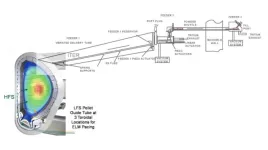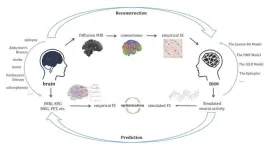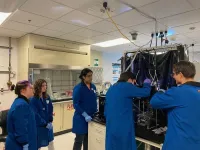(Press-News.org) (WASHINGTON – October 7, 2024) - A new study finds that preschool-aged children with sickle cell disease (SCD) who live in food deserts and have limited access to transportation are at greater risk for acute complications and hospitalizations, despite receiving free evidence-based therapy and social support, according to results published today in Blood Advances.
“Despite the level of care received by the families and patients within our clinic, we still have a gap in terms of being able to address the barriers they're experiencing within the community,” said senior study author Jason Hodges, PhD, MA, director of research and clinical studies in the Department of Hematology at St. Jude’s Children’s Research Hospital in Memphis. “We need to think about the neighborhood and context that these patients and families are coming from because that has a huge impact on health.”
While previous studies have shown that social determinants of health (SDoH) – the conditions in which people are born, grow, work, live, and learn – can impact the health of children with SCD, less is known about how community-level factors, such as transportation access, income level, education attainment, and proximity to a grocery store may contribute to health disparities in these patients.
For this study, Dr. Hodges and his team wanted to take a more granular look at specific community-level SDoH – for example, household distance from grocery stores, number of children in the household, vehicle ownership, neighborhood income, and parental education levels – to assess whether these factors are associated with increased acute care utilization (ACU), including emergency department visits and hospitalizations, among preschool-aged children with SCD.
The researchers analyzed demographic, treatment, and ACU data for 435 children ages 0-6 years (median of 5.7 years) enrolled in the Sickle Cell Disease Clinical Research and Intervention Program, a longitudinal study evaluating the treatment, health care use, and outcomes of individuals living with SCD throughout their lifespan. Participants’ home addresses were mapped and grouped by census tract and compared with census-level data on household poverty levels and food access from the U.S. Department of Agriculture Food Access Research Atlas.
All participants were Black. Half (52%) were female, and just over half (60%) of participants had the severe SCD genotype (HbSS/HbSb0thalassemia). Forty-three percent (43%) of the patients resided in neighborhoods identified by the U.S. Census as being particularly vulnerable to hardship. All participants were receiving the standard of care, hydroxyurea and/or monthly transfusions when needed, as well as social support, including transportation and meal services when they came for their appointments.
After controlling for sickle SCD genotype and disease-modifying therapy, the team found that living in a household located more than one mile from a supermarket was associated with a 44% increase in hospitalizations and a 37% increase in ACU among children with SCD ages 0-6 years. Living in a household more than a mile from a grocery store and without a vehicle was associated with a significantly higher likelihood of being hospitalized before age six. Conversely, in the households with an adult holding at least one bachelor’s degree (11.7%), children with SCD were 33% less likely to experience ACU and hospitalizations respectively, suggesting parental education level could have a protective effect.
“The data suggest that, regardless of how much care you provide and how many new therapies are out there for patients who have chronic illnesses like SCD, unless you start addressing these deep-rooted issues, like food deserts or quality of life from the neighborhood standpoint, it's always going to be extremely tricky to holistically provide care to our patient population,” said lead study author Hamda Khan, MA, a clinical research associate in the Department of Hematology at St. Jude’s Children’s Research Hospital.
Khan and Dr. Hodges hope these data about the impact of neighborhoods and other community-level SDoH on the health of patients with SCD will help shape public policy to bring more resources and public health interventions to these high-need areas. They say further research should focus on household size, health care maintenance visits, and environmental hazards like air pollution to better understand the impact of environmental SDoH on this patient population.
The authors cautioned that this research is specific to children with SCD ages 0-6 years who received wrap-around care and social support and may not reflect the experience of older patients with SCD, patients who have relocated to areas with better access to resources, or those not receiving support services. Additional limitations may include insufficient data on adherence to disease-modifying therapy.
SCD is the most common inherited blood cell disorder in the United States, affecting an estimated 100,000 people and one out of every 365 Black or African American births. SCD is characterized by misshapen red blood cells that can block blood vessels, causing episodes of severe pain, as well as damage to tissues and organs.
###
Blood Advances (bloodadvances.org) is an online, open-access journal publishing more peer-reviewed hematology research than any other academic journal worldwide. Blood Advances is part of the Blood journals portfolio (bloodjournals.org) from the American Society of Hematology (ASH) (hematology.org).
Claire Whetzel, 202-629-5085
cwhetzel@hematology.org
END
Researchers have discovered the most distant Milky-Way-like galaxy yet observed. Dubbed REBELS-25, this disc galaxy seems as orderly as present-day galaxies, but we see it as it was when the Universe was only 700 million years old. This is surprising since, according to our current understanding of galaxy formation, such early galaxies are expected to appear more chaotic. The rotation and structure of REBELS-25 were revealed using the Atacama Large Millimeter/submillimeter Array (ALMA), in which the European ...
A common theory that guides financial investment strategies may be a handy tool to protect an endangered Puerto Rican frog. A new study uses modern portfolio theory to identify future “investments” in natural resource management that may help managers decide which actions to take to protect coquí llanero populations in Puerto Rico.
The 17 species of coquí frogs, and their signature high-pitched chirp, are considered unofficial mascots of Puerto Rico. The entire population of coquí llanero frogs, the smallest and possibly most endangered of the island’s coquís, ...
Fusion researchers are increasingly turning to the element tungsten when looking for an ideal material for components that will directly face the plasma inside fusion reactors known as tokamaks and stellarators. But under the intense heat of fusion plasma, tungsten atoms from the wall can sputter off and enter the plasma. Too much tungsten in the plasma would substantially cool it, which would make sustaining fusion reactions very challenging. Now, researchers at the U.S. Department of Energy’s Princeton Plasma Physics Laboratory (PPPL) have experimental results suggesting that sprinkling ...
Developing new cancer treatment tools, using imaging techniques such as PET-CT and MRI, and new radiopharmaceuticals for next-generation personalized therapies (“Theranostics”) to target cancer first at the “diagnosis” phase and then at the “therapy” phase, using the same biological targets (“see to treat”). Additionally, the project aims to develop and implement AI-based tools for data sharing among research and hospitals, supporting clinical decisions and predicting individual patient treatment response and outcome.
This is the main ...
Vaccines to prevent common and serious infectious diseases have had a greater impact on improving human health than any other medical advance of the 20th century, surpassing even sanitation and potable water. From the global eradication of smallpox in 1980 to the unprecedented development of effective and safe mRNA vaccines for COVID-19, vaccinations have played crucial roles in preventing millions of premature deaths and hospitalizations in adults and children.
These monumental efforts have involved coordinated local, regional, national and international organizations and dedicated clinical ...
With hundreds of observatories scattered throughout the world, there has never been a better time for astronomers to observe the infinite universe that lies beyond Earth. At any moment in time, a telescope pointed at the night sky can observe new transient phenomena, such as supernovae that brighten rapidly and then fade away over days to months, releasing massive amounts of energy in the process. These events are rare in any single galaxy and each gives researchers more insight into the dynamic time-domain sky.
But what if these observatories could work even closer together to view these important astronomical events?
The National ...
A research team from the International Research Institute for Artificial Intelligence at Harbin Institute of Technology, Shenzhen, has recently published a comprehensive review in the journal Health Data Science on the application of Brain Network Models (BNMs) in the medical field. This study summarizes recent advances and challenges in using BNMs to simulate brain activities, understand neuropathological mechanisms, evaluate therapeutic effects, and predict disease progression.
Brain Network Models ...
NEWPORT NEWS, VA – Four physicists affiliated with the U.S. Department of Energy’s Thomas Jefferson National Accelerator Facility have been selected by their peers for the distinct honor of Fellow of the American Physical Society.
“Our staff power the science and innovation that are continuing to move the discipline of physics and this laboratory into the future,” said Jefferson Lab Director Kim Sawyer. “We’re very proud that the accomplishments and contributions of these four Jefferson Lab staff members to the field of physics are being recognized by their peers with this honor.”
According to the APS, fellows have made ...
COLUMBUS, Ohio – Psychiatric drugs are reported to be about 50% more effective in clinical trials funded by the drug’s manufacturer than when trials of the same drug are sponsored by other groups, new research shows.
While many studies have found more favorable results for drugs in clinical trials funded by their manufacturers, these studies normally just compare a set of manufacturer-funded studies with a set of studies funded in other ways, said Tamar Oostrom, assistant professor of economics at The Ohio State University, who conducted this new research.
This ...
UTSA was selected by the U.S. Department of Energy’s (DOE) Office of Nuclear Energy (NE) to lead a multimillion-dollar project that will stimulate nuclear energy research at UTSA, leverage novel experimental data to bolster computational efforts at the university, and provide professional training to prepare undergraduate and graduate students for careers in nuclear energy science. UTSA researchers will collaborate with a leading nuclear energy laboratory as well as across academic institutions.
The award is part of the DOE’s Nuclear Energy University Program’s Integrated Research Projects (IRPs). These projects aim to provide research and development solutions ...






